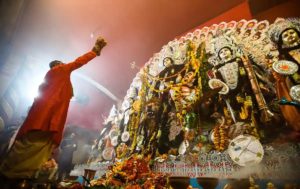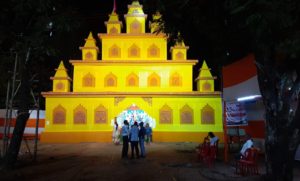Barak UpdatesHappeningsBreaking News
Amid Covid scare, Durga Puja begins with devotees offering prayers on Maha Saptami

Oct. 12: The festive mood of Durga Puja, 2021 has already been dampened by the ongoing coronavirus pandemic. In almost all major states including Assam, several restrictions were put in place to put on hold the further spread of the deadly virus during the festival season. Due to COVID-19, the Durga Puja arrangements were already a low-key affair. However, overcoming all odds, devotees went to offer Pushpanjali on Maha Saptami, of course obeying the Covid protocol.

 Goddess Durga, also identified as Shakti, Bhavani and Adi Parashakti, is always depicted as a fearless Goddess whose mythology revolves around winning of good over evil. The nation has come a long way since 1947. It is expected that the people have grown in maturity and so it can be expected that before thousands set out of their houses for pandal-hopping, they themselves will exhibit enough maturity by maintaining ‘social distancing’ not for fear of law but for keeping themselves out from the clutches of ‘Coronasur.’ Devotees can only hope and pray that Mahishasur Mardini in the incarnation of Coronasur Mardini will slain the virus and get rid our planet earth of the suffocating face mask.
Goddess Durga, also identified as Shakti, Bhavani and Adi Parashakti, is always depicted as a fearless Goddess whose mythology revolves around winning of good over evil. The nation has come a long way since 1947. It is expected that the people have grown in maturity and so it can be expected that before thousands set out of their houses for pandal-hopping, they themselves will exhibit enough maturity by maintaining ‘social distancing’ not for fear of law but for keeping themselves out from the clutches of ‘Coronasur.’ Devotees can only hope and pray that Mahishasur Mardini in the incarnation of Coronasur Mardini will slain the virus and get rid our planet earth of the suffocating face mask.

Durga Puja, also referred to as Durgotsava or Sharadotsav is an annual Hindu festival, especially of the Bengalis who celebrates worship of the Hindu goddess Durga. It refers to all the six days observed as Mahalaya, Sashthi, Maha Saptami, Maha Ashtami, Maha Nabami and Vijayadashami. Durga Puja festival is celebrated from the sixth to tenth day of bright lunar fortnight in the Hindu calendar month of Ashvin. This period falls in the fortnight corresponding to the festival is called Devi Paksha. Devi Paksha is preceded by Mahalaya, the last day of the previous fortnight Pitri Paksha, and ends on Kojagori Lokkhi Puja.
 On the early hours of Saptami, Goddess Durga is invoked in a group of nine plants bunched together, called Navapatrika, and tied to the twigs of white Aparajita plant with a yellow thread. These nine plants represent the nine manifestations of Goddess. The Navapatrika is given a pre-dawn bath in the Ganga water along with the chanting of hymns.
On the early hours of Saptami, Goddess Durga is invoked in a group of nine plants bunched together, called Navapatrika, and tied to the twigs of white Aparajita plant with a yellow thread. These nine plants represent the nine manifestations of Goddess. The Navapatrika is given a pre-dawn bath in the Ganga water along with the chanting of hymns.

The nine planets of Nabapatrika represent nine Goddesses: Banana plant: Goddess Brahmani, Colocasia plant: Goddess Kalika, Turmeric plant: Goddess Durga, Jayanti plant: Goddess Kartiki, Bel leaves: Lord Shiva, Pomegranate leaves: Goddess Raktadantika, Asoka leaves: Goddess Shokarahita, Arum plant: Goddess Chamunda and Rice paddy: Goddess Lakshmi. The ritual of Navapatrika is followed by ‘Maha Snan’ (The Grand Bathing). This is one of the most important rituals. A mirror is placed in front of Goddess Durga’s idol. The reflection in the mirror is given a bath and is known as Maha Snan.
 After the Maha Snan gets over, the priest amid chanting of hymns does the ‘Pranpratistha.’ The aim of Pranpratistha is to awaken the spirit of Goddess Durga. A pitcher full with water is placed in front of the idol. A bunch of five mango leaves is placed on the top of the pitcher and a coconut is placed over it. It is believed that ‘Mahisasur Mardini’ Durga starts her battle against demon Mahisasur and finally wins back the peace and tranquility of heaven after slaying the buffalo demon ‘Mahisasur.’
After the Maha Snan gets over, the priest amid chanting of hymns does the ‘Pranpratistha.’ The aim of Pranpratistha is to awaken the spirit of Goddess Durga. A pitcher full with water is placed in front of the idol. A bunch of five mango leaves is placed on the top of the pitcher and a coconut is placed over it. It is believed that ‘Mahisasur Mardini’ Durga starts her battle against demon Mahisasur and finally wins back the peace and tranquility of heaven after slaying the buffalo demon ‘Mahisasur.’
At Silchar, devotees thronged the puja pandals in the morning of Maha Saptami in groups to offer ‘Puspanjali’ to Goddess Durga wearing new clothes. Prayers were offered to Goddess Durga to keep all beings in peace and tranquility.





